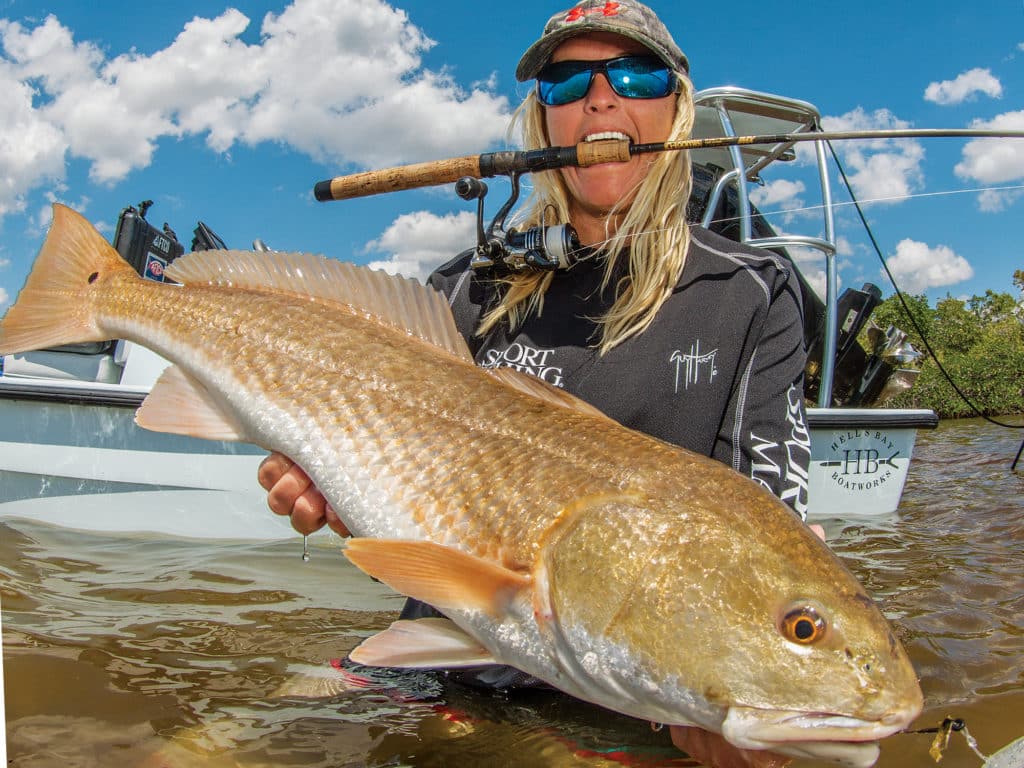
In south Texas’ glassy inshore waters, Capt. Brian Barrera of South Padre Island targets redfish, seatrout and even snook using jig heads and soft baits on light leaders. He catches spooky fish in the clear waters — but to do so, he has to downsize his tackle.
“Sight-fishing in 8 inches of water, I have to drop down from 20- to 10-pound braid to make longer casts,” says Barrera. “Jig heads must be ⅛ to 1⁄16 ounces. Four- to 6-inch finger mullet require smaller hooks, too. Don’t use a swivel to connect braid to leader; instead use a line-to-leader knot.”
Because fish are often on edge in his local waters, Barrera prefers to fish greener, off-color waters around his local sand flats. He’s also meticulous about not crowding the fish he’s targeting. “I really try to limit boat noise,” he points out. “You want your casts to be as long as possible to reach undisturbed fish.”
For Barrera, a switch to lighter tackle is a vital strategy for increased hookups. Other top captains along coastal shores employ similar tactics. Consider the scenarios below, each one describing a dramatically different fishery. The captains I interviewed all trim down their tackle differently for success. Chances are you can utilize some of the same techniques the next time you downsize.
Late-Season Jitters
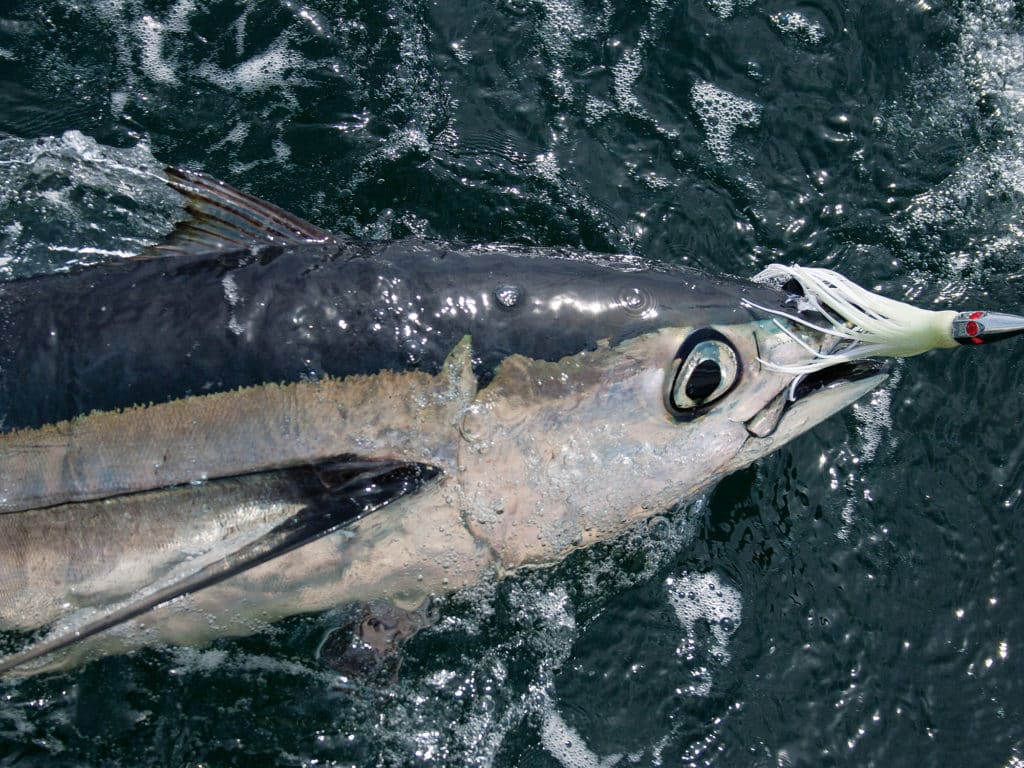
Albacore are sized favorably to succumb to light tackle in the Pacific Northwest. “During the early season on the West Coast [starting in mid-June], albacore tuna tend to be very naive and susceptible to fast-trolled surface lures,” says Capt. Mark Coleman, of All Rivers & Saltwater Charters in Westport, Washington.
For anglers, it’s easy fishing for the tasty tuna just two hours off the Washington coast. But as the season progresses, these fish move off the troll gear and prefer live baits on a dead-boat drift. Most of the anchovies used as bait are small in stature, measuring just 4 to 6 inches.
“I have found that by downsizing our trolling lures and cutting our trolling speed in half, we can bring back the excellent trolling action we experience in the early season,” says Coleman.
But why troll when the action’s wide-open on live bait? Well, many times, longfins aren’t feeding at the surface, and that makes them hard to find. “Along with a few other indicators, trolling hookups help us locate the fish,” he explains. “Downsizing your leader from 30- to 20-pound and decreasing your hook size from a No. 1 to 4 make a big difference.”
A Light in the Dark
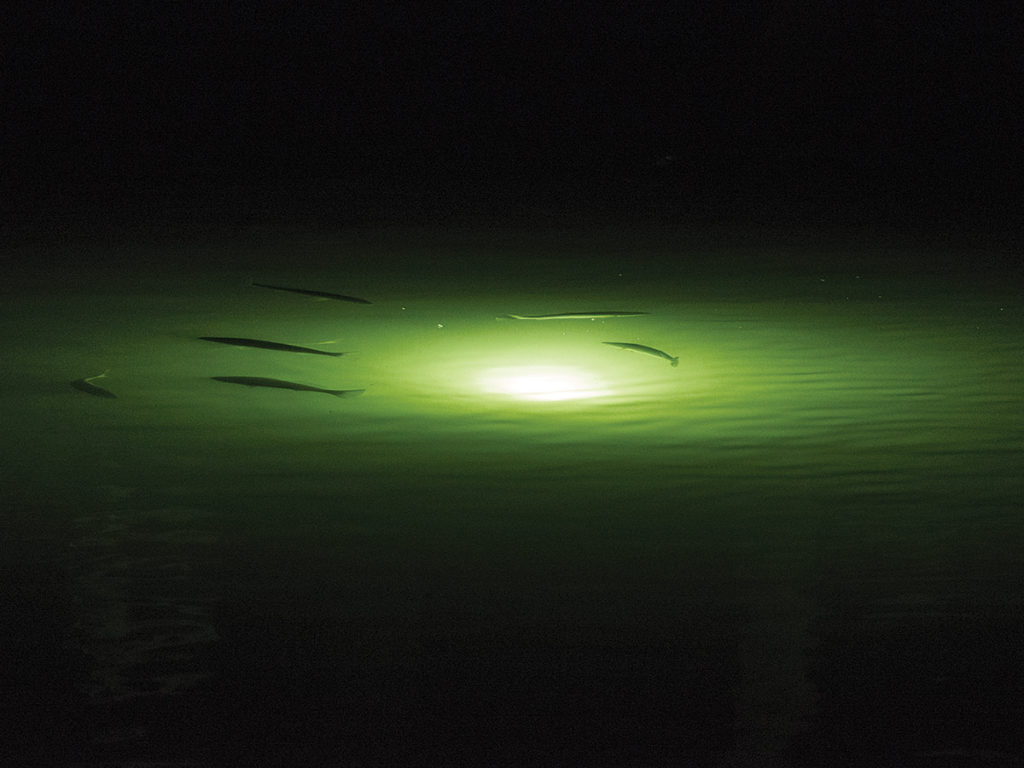
In South Florida, nighttime anglers in skiffs position down-current of docks outfitted with LEDs. The tiny shrimp, baitfish and plankton clouds attracted to the halos of light tempt game fish such as snook, speckled seatrout and redfish. Because the baits are so small, lobbing a big plug or live bait up-current near the dock is an awful strategy. Often the water is clear, too, so casting bait or lures too large, or getting a boat too close to the structure, spooks that prize swimming along the shadow line.
Fly-anglers favor casting baitfish imitators, such as white Clouser flies on 6- and 8-weight outfits. Personally, I remember many nights fishing with friends and doing pretty well on spin tackle; still, nearby boats casting fly tackle ate our lunch. The only instances we could match fly tackle fish-for-fish occurred when snook targeted our D.O.A or Gulp! shrimp tied to 20-pound fluorocarbon leader.
Bait size matters at night for stripers, too.
“We call it fire in the water,” says Capt. Jay Cianciolo, of Laura-Jay Sportfishing Charters in Sandwich, Massachusetts. When there’s lots of phosphorus and other nutrients in the water, increased numbers of dinoflagellates turn on the light show of bioluminescence to evade predators.
“That’s when I drop down to small ‘pencil’ eels,” he says. “Big eels leave trails in the water, which I believe might push stripers off the feed. [In these circumstances] small eels always get bit better.”
Spinning Tackle for the Win
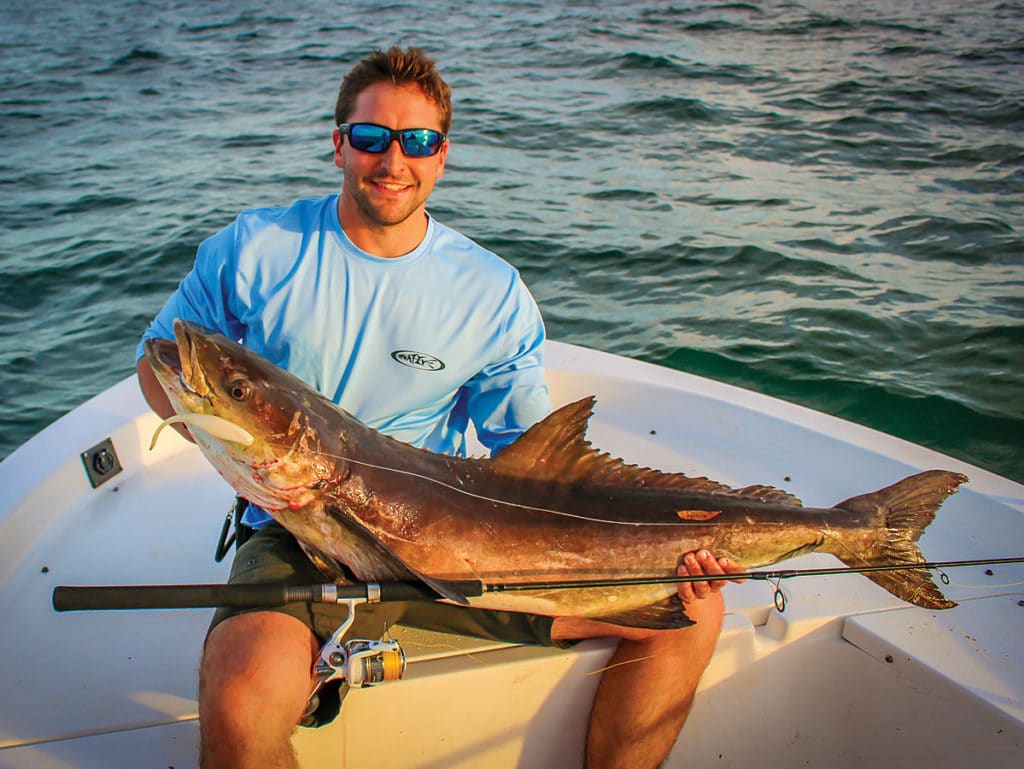
Cobia are great light-line adversaries, and not enough anglers take advantage of the unique species on scaled-back tackle. The visual fishery across southeastern and mid-Atlantic waters makes a ling’s aggressive bite and fight all the more exciting to light-tackle anglers.
“I know many captains who use levelwinds like Shimano TLDs, Avets, Accurates and many others,” says Capt. Brandon Long, of Long Overdue Charters in Charleston, South Carolina. “But over the past couple of years I’ve gone lighter and started having much more fun with cobia.”
Long fishes the brown bombers using 4,000- to 6,000-size spinning reels paired with medium-light rods. You don’t want the 4,000 in your hand when an 80-pounder pops up boatside, but for fish in the 15- to 50-pound class, it’s ideal.
“Lighter tackle makes it much easier to cast, present to and feed these fish with smaller plastics and hard baits,” says Long. “I fish 4- to 9-inch Z-Man Jerk ShadZ, smaller subsurface hard baits, and ½- to 3-ounce bucktails rigged with trailers.”
When Long downsizes his reels, he upgrades his drag washers. He also spools his reels with 20- to 30-pound braided line to guarantee sufficient line capacity, terminating with 50- or 60-pound mono leader.
“Felt drag washers will get destroyed by fish if not greased properly,” Long points out. “To avoid this issue, I replace all my drag washers with carbon washers from companies such as Carbontex; the strength and heat diffusion these washers handle produce much smoother fights.”
Fish the Docks During the Day
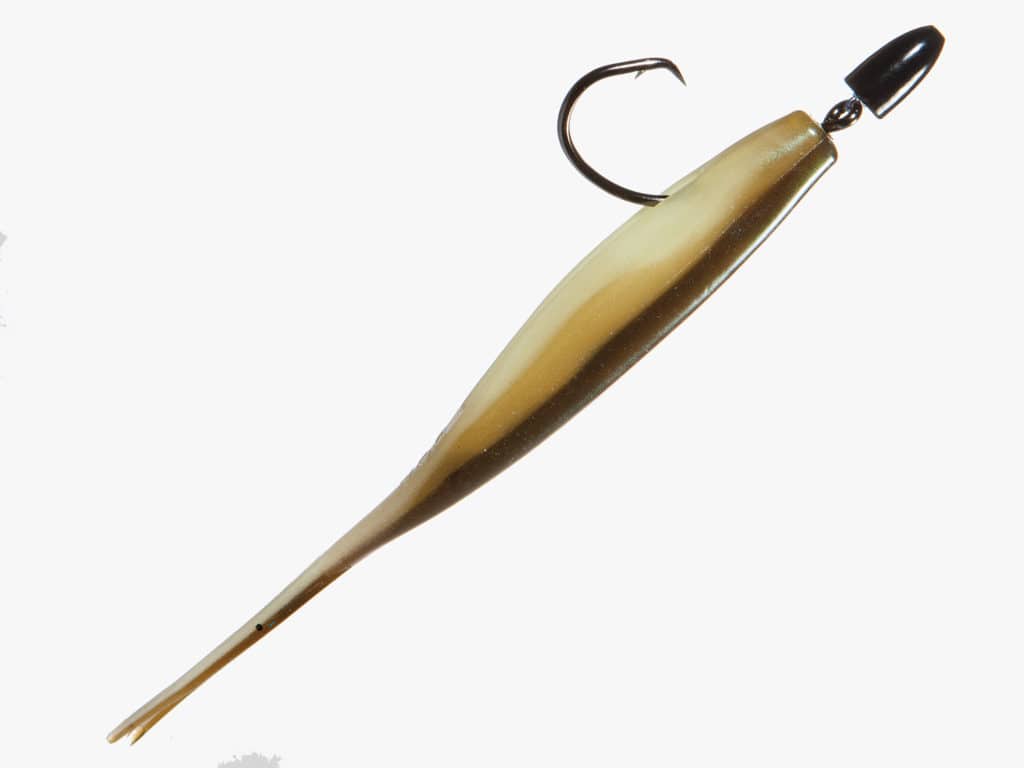
Targeting tarpon and snook in the Brownsville ship channel and basin, Capt. Brian Barrera focuses on the deep sections of channel, along dock structure, and on freshwater runoff channels called resacas. Instead of trolling heavy gear around the jetties (a preferred tactic in the area), Barrera uses home-crafted soft baits to cast deep into the legs of docks.
The bait consists of a ⅛-ounce Tungsten bullet weight atop a 2/0 to 5/0 octopus 4x circle hook. A jerkbait holds to the circle hook with a screw lock or hitchhiker.
“Those tarpon come out from the docks in the morning, but go back into the pilings when the sun’s up,” says Barrera. “I cast far back under the docks and use 20- to 30-pound fluoro leader to get them to bite during the day.”
Play the Odds
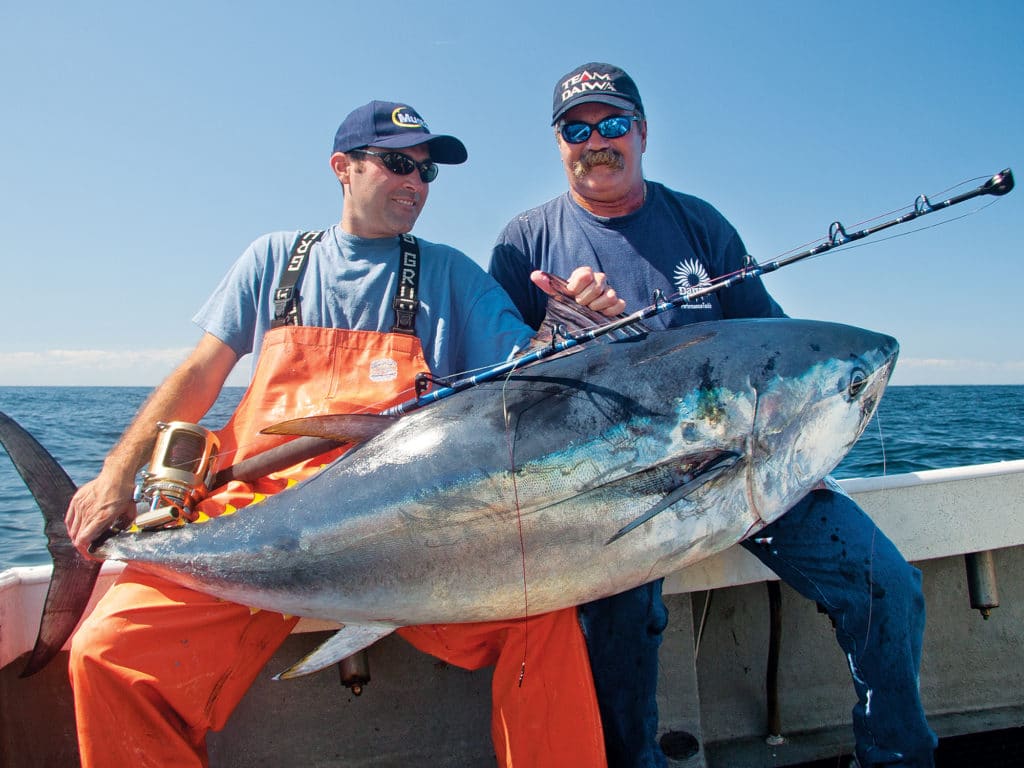
Capt. Jay Cianciolo can’t help but gamble. Live-baiting for trophy bluefin tuna far off the coast, he sometimes marks fish on the sounder when he can’t buy a bite.
“That’s when I’ll gamble,” says Cianciolo. “I’ll drop down to 130 fluorocarbon leader and an 8/0 circle hook.” That might not seem like light tackle, but large bluefins often necessitate 11/0 hooks and 180-plus-pound leader. “Usually, I’ll start getting bites then,” he says, “even though I definitely don’t land them all.”
The gambit is worthwhile for Cianciolo, especially when line-shy fish require lighter leaders. You don’t have to take the same risks with light tackle, and plenty of opportunities are available for anglers to downsize their gear and still maintain high landing percentages. So whether fishing inshore, nearshore or far offshore, consider dropping some of that tackle weight — it might just turn into your most productive trip of the season.








